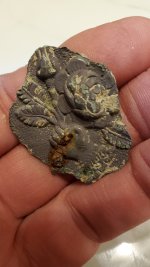A
abrakdabra
Guest
? ?Hi fellow md'ers. Any advice on this topic would be appreciated. I thought I had a method for caring for uncovered old relics but my method isn't successful.
? ?I use a brass brush to get the dirt off which often reveals a form very different once the soil is removed. Gently. Then I simply spray them with WD-40. The problem, I think, may be that these relics are very, very old. In some cases 1,500 years old. I'm in Korea and there's a lot of iron from that time, the use of iron was very common. So what I find is iron arrowheads, bits of fasteners from horse-riding, and so on. I read on the can that WD-40 'draws out moisture' while at the same time preserving and protecting. That may be fine for modern metal, but not these items. I have no idea. All I can do is guess. But I think drawing out the moisture is causing the fragmenting and flaking. The items held together in the wettish soil all those years, but exposed to dry conditions of a storage box after having the moisture drawn out by WD-40 disappointingly causes them to fall apart to a degree and I wish I could avoid this. By using some other method.
? ?I don't know what museums do, but in museum displays showing items of this age I see that some coating has been applied that seems to hold them together and seal them up. They shine to a degree, like it's a plastic or I don't know what.
? ?Thanks for any suggestions, I reallly appreciate it.
? ?I use a brass brush to get the dirt off which often reveals a form very different once the soil is removed. Gently. Then I simply spray them with WD-40. The problem, I think, may be that these relics are very, very old. In some cases 1,500 years old. I'm in Korea and there's a lot of iron from that time, the use of iron was very common. So what I find is iron arrowheads, bits of fasteners from horse-riding, and so on. I read on the can that WD-40 'draws out moisture' while at the same time preserving and protecting. That may be fine for modern metal, but not these items. I have no idea. All I can do is guess. But I think drawing out the moisture is causing the fragmenting and flaking. The items held together in the wettish soil all those years, but exposed to dry conditions of a storage box after having the moisture drawn out by WD-40 disappointingly causes them to fall apart to a degree and I wish I could avoid this. By using some other method.
? ?I don't know what museums do, but in museum displays showing items of this age I see that some coating has been applied that seems to hold them together and seal them up. They shine to a degree, like it's a plastic or I don't know what.
? ?Thanks for any suggestions, I reallly appreciate it.





